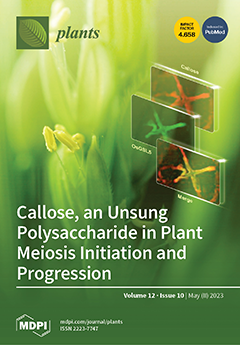Arabidopsis thaliana ecotypes adapted to native habitats with different daylengths, temperatures, and precipitation were grown experimentally under seven combinations of light intensity and leaf temperature to assess their acclimatory phenotypic plasticity in foliar structure and function. There were no differences among ecotypes when plants developed under moderate conditions of 400 µmol photons m
−2 s
−1 and 25 °C. However, in response to more extreme light or temperature regimes, ecotypes that evolved in habitats with pronounced differences in either the magnitude of changes in daylength or temperature or in precipitation level exhibited pronounced adjustments in photosynthesis and transpiration, as well as anatomical traits supporting these functions. Specifically, when grown under extremes of light intensity (100 versus 1000 µmol photons m
−2 s
−1) or temperature (8 °C versus 35 °C), ecotypes from sites with the greatest range of daylengths and temperature over the growing season exhibited the greatest differences in functional and structural features related to photosynthesis (light- and CO
2-saturated capacity of oxygen evolution, leaf dry mass per area or thickness, phloem cells per minor vein, and water-use efficiency of CO
2 uptake). On the other hand, the ecotype from the habitat with the lowest precipitation showed the greatest plasticity in features related to water transport and loss (vein density, ratio of water to sugar conduits in foliar minor veins, and transpiration rate). Despite these differences, common structure–function relationships existed across all ecotypes and growth conditions, with significant positive, linear correlations (i) between photosynthetic capacity (ranging from 10 to 110 µmol O
2 m
−2 s
−1) and leaf dry mass per area (from 10 to 75 g m
−2), leaf thickness (from 170 to 500 µm), and carbohydrate-export infrastructure (from 6 to 14 sieve elements per minor vein, from 2.5 to 8 µm
2 cross-sectional area per sieve element, and from 16 to 82 µm
2 cross-sectional area of sieve elements per minor vein); (ii) between transpiration rate (from 1 to 17 mmol H
2O m
−2 s
−1) and water-transport infrastructure (from 3.5 to 8 tracheary elements per minor vein, from 13.5 to 28 µm
2 cross-sectional area per tracheary element, and from 55 to 200 µm
2 cross-sectional area of tracheary elements per minor vein); (iii) between the ratio of transpirational water loss to CO
2 fixation (from 0.2 to 0.7 mol H
2O to mmol
−1 CO
2) and the ratio of water to sugar conduits in minor veins (from 0.4 to 1.1 tracheary to sieve elements, from 4 to 6 µm
2 cross-sectional area of tracheary to sieve elements, and from 2 to 6 µm
2 cross-sectional area of tracheary elements to sieve elements per minor vein); (iv) between sugar conduits and sugar-loading cells; and (v) between water conducting and sugar conducting cells. Additionally, the proportion of water conduits to sugar conduits was greater for all ecotypes grown experimentally under warm-to-hot versus cold temperature. Thus, developmental acclimation to the growth environment included ecotype-dependent foliar structural and functional adjustments resulting in multiple common structural and functional relationships.
Full article






